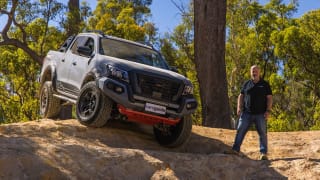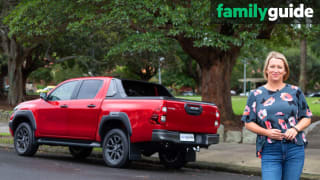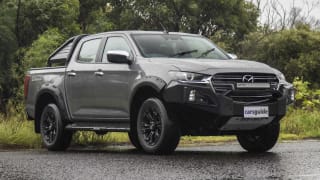Based on the engine family first seen in the old Australian Ford Territory TDCi turbo-diesel, and more recently in the US-market Ford F-150 full-sized truck range, all eyes are on the big new 3.0-litre V6 turbo-diesel.
Available in the XLT (from $62,290 before on-road costs), Sport (from $66,690 before ORC) and Wildtrak (from $70,190 before ORC) only for now, it has few peers with outputs of 184kW at 3250rpm and 600Nm at 1750-2250rpm.
The V6 sends drive through to a new electronic on-demand four-wheel-drive system, with full-time 4WD that varies drive to the front or rear wheels as required. It includes six driving modes: Normal, Eco, Tow/Haul and Slippery for on-road driving, and Mud/Ruts and Sand for use off-road. Each alter engine throttle, transmission, braking, traction and stability controls.
Explore the 2023 Ford Ranger range
There’s also an electronic rear differential lock which can be activated via the SYNC 4A multimedia screen, for improved off-road traction.
A built-in trailer wiring set-up is also included, as well as the tow bar itself for all V6 variants.
By the way, Ranger 4x4s with either 2.0-litre engine stick with the standard part-time 4x4 set-up that offers 4x2 (rear-drive), 4x4 Low range and 4x4 High range.
On the fuel consumption front, the V6 turbo-diesel is actually a whole half-a-litre per 100km more economical than the old 3.2-lite five-pot turbo-diesel.
The official combined average consumption in the 3.0-litre V6 turbo-diesel 4WD is 8.4L/100km, for 222g/km of CO2 emissions and an average distance range of 952km.
So, what's the 3.0 V6 turbo-diesel like to drive?
Reminiscent of theTerritory TDCi, it is slick and sophisticated, yet offers more punch than Australia’s only locally-built SUV ever managed.
In a nutshell, the V6 amplifies the acceleration and performance of the significantly improved and rapid 2.0-litre BiTurbo, thrusting forward with determination, accompanied by a more stirring V6 soundtrack.
Additionally, the 10-speed auto is even more relaxed an its smaller brother, and with greater torque levels to draw upon, it’s both more responsive to throttle inputs and less likely to hunt through the gears.
Better around town, stronger out on the open road and more reassuring when you need to overtake, especially at speed or blasting up a hill.
For this and other reasons, the $3000 premium paid for going the V6 is definitely worthwhile, and backed up by very reasonable combined-average fuel consumption figures of 8.4L/100km.












